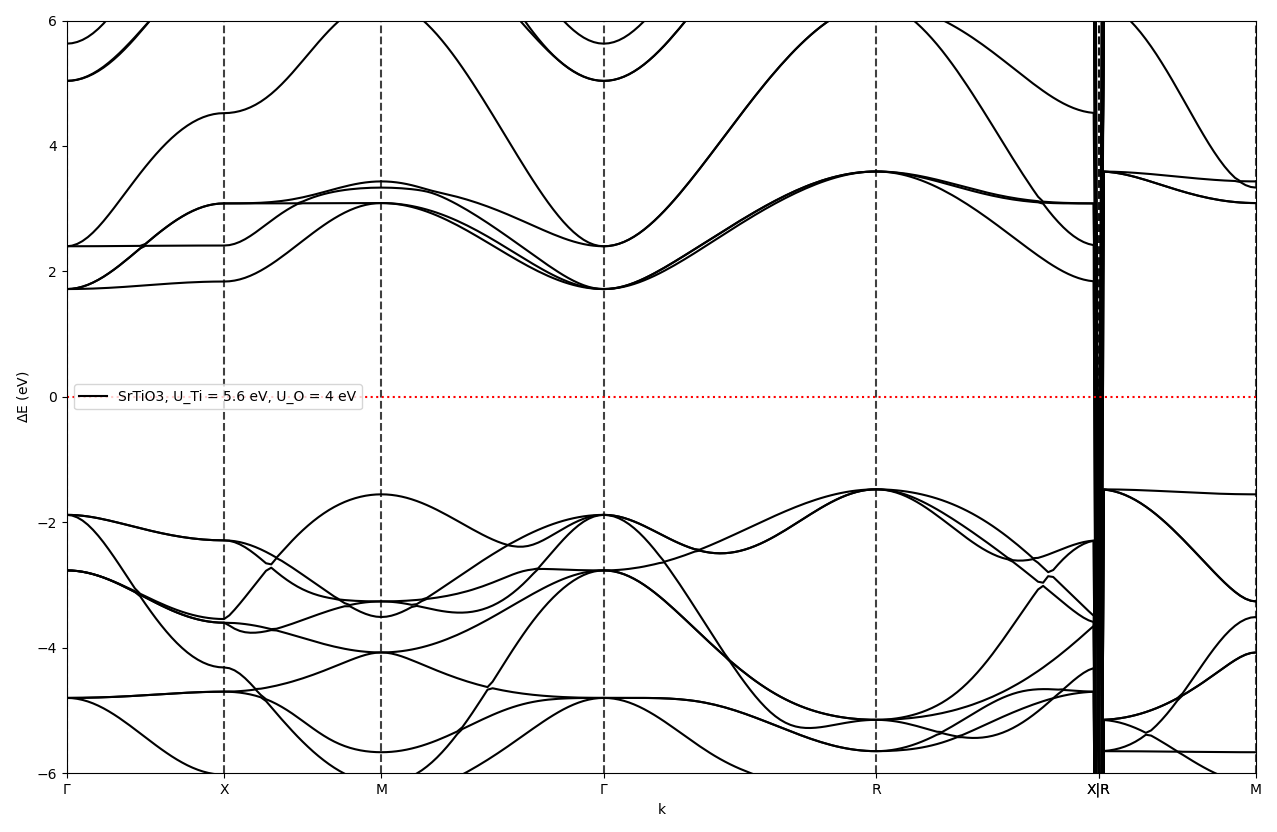the last few days I've tried to calculate the phonon-dispersion of SrTiO3 (STO) and EuTiO3 (ETO) using the PHonon package of QE. SCF, DOS, PDOS and Bandsctructure calculation worked well on these materials, I've used a Hubbard-correction for both. My scf.in file for STO looks as follows:
STO:
&CONTROL
calculation = 'scf'
outdir = './out/'
prefix = 'STO_gamma'
pseudo_dir = './nc-sr-04_pbe_stringent_upf/'
/
&SYSTEM
! a = 3.94513 # old value before vc-relax.x
A = 3.93795
degauss = 0.005
ecutwfc = 80
lda_plus_u=.true.
lda_plus_u_kind = 0
hubbard_u(1) = 0
hubbard_u(2) = 5.6
hubbard_u(3) = 4
ibrav = 0
nbnd = 33
nat = 5
nosym = .false.
nspin = 2
ntyp = 3
occupations = 'smearing'
starting_magnetization(1) = 1.0d-01
starting_magnetization(2) = 1.0d-01
starting_magnetization(3) = 4.16d-01
/
&ELECTRONS
conv_thr = 1.d-10
mixing_beta = 0.7
/
ATOMIC_SPECIES
Sr 87.62000 Sr.upf
Ti 47.86700 Ti.upf
O 15.99940 O.upf
CELL_PARAMETERS {alat}
0.998180509 0.000000000 0.000000000
0.000000000 0.998180509 0.000000000
0.000000000 0.000000000 0.998180509
ATOMIC_POSITIONS {crystal}
Sr 0.0000000000 0.0000000000 0.0000000000
Ti 0.5000000000 0.5000000000 0.5000000000
O 0.5000000000 0.0000000000 0.5000000000
O 0.5000000000 0.5000000000 0.0000000000
O 0.0000000000 0.5000000000 0.5000000000
K_POINTS {automatic}
16 16 16
The pesudopotentials are the norm conserving potentials from pseudo-dojo.org. The bandstructure shows an energy gap of about 3.2 eV with these settings. 
The ph.x input looks like:
phonon calculation at Gamma point.
&inputph
outdir = './out/'
prefix = 'STO_gamma'
tr2_ph = 1.0d-3
nmix_ph = 10
epsil = .false.
amass(1) = 87.62000
amass(2) = 47.86700
amass(3) = 15.99940
fildyn = 'STO_phonon.dyn'
/
0 0 0
The output generated by dynmat.x after applying the acustic sum rule = crystal looks like:
# mode [cm-1] [THz] IR
1 -6235.76 -186.9435 0.0000
2 -6235.76 -186.9435 0.0000
3 -6235.76 -186.9435 0.0000
4 -4352.85 -130.4953 0.0000
5 -4352.85 -130.4953 0.0000
6 -4352.85 -130.4953 0.0000
7 -4105.78 -123.0883 0.0000
8 -4105.78 -123.0883 0.0000
9 -4105.78 -123.0883 0.0000
10 -2138.73 -64.1174 0.0000
11 -2138.73 -64.1174 0.0000
12 -2138.73 -64.1174 0.0000
13 0.00 0.0000 0.0000
14 0.00 0.0000 0.0000
15 0.00 0.0000 0.0000
This calculation alone took over 3 hours only for the gamma point. The input file for my scf calculation of ETO looks like
ETO:
&CONTROL
calculation = 'scf'
outdir = './out/'
prefix = 'EuTiO3'
pseudo_dir = './pseudo/'
/
&SYSTEM
a = 3.9611945300
degauss = 0.01
ecutrho = 600
ecutwfc = 75
lda_plus_u=.true.
lda_plus_u_kind = 0
hubbard_u(1) = 9
hubbard_u(2) = 0
hubbard_u(3) = 0
ibrav = 1
nat = 5
nosym = .false.
nspin = 2
ntyp = 3
occupations = 'smearing'
smearing = 'mv'
starting_magnetization(1) = 4.1176470588d-01
starting_magnetization(2) = 1.0000000000d-01
starting_magnetization(3) = 4.1666666667d-01
/
&ELECTRONS
conv_thr = 1.0000000000d-06
electron_maxstep = 1000
mixing_beta = 4.0000000000d-01
/
ATOMIC_SPECIES
Eu 151.964 Eu.GGA-PBE-paw-v1.0.UPF
O 15.9994 O.pbe-n-kjpaw_psl.0.1.UPF
Ti 47.867 ti_pbe_v1.4.uspp.F.UPF
ATOMIC_POSITIONS {crystal}
Eu 0.0000000000 0.0000000000 0.0000000000
Ti 0.5000000000 0.5000000000 0.5000000000
O 0.5000000000 0.5000000000 0.0000000000
O 0.5000000000 0.0000000000 0.5000000000
O 0.0000000000 0.5000000000 0.5000000000
K_POINTS {automatic}
6 6 6 0 0 0
Bandstructure with band gap of about 1.05 eV: The ph.x input is:
The ph.x input is:
!phonons of EuTiO3 at Gamma
&inputph
prefix = 'EuTiO3'
outdir = './out/'
tr2_ph = 1.0d-14
amass(1) = 151.964
amass(2) = 15.9994
amass(3) = 47.867
! epsil = .true.
! lraman .true.
fildyn='EuTiO3.dynG'
/
0.000000000000000 0.000000000000000 0.000000000000000
Which got me the following phonon frequencies (again asr = crystal):
# mode [cm-1] [THz] IR
1 -636.90 -19.0939 0.0000
2 -636.90 -19.0939 0.0000
3 -636.90 -19.0939 0.0000
4 -547.18 -16.4041 0.0000
5 -547.18 -16.4041 0.0000
6 -547.18 -16.4041 0.0000
7 -401.41 -12.0340 0.0000
8 -401.41 -12.0340 0.0000
9 -401.41 -12.0340 0.0000
10 -0.00 -0.0000 0.0000
11 -0.00 -0.0000 0.0000
12 0.00 0.0000 0.0000
13 64.61 1.9371 0.0000
14 64.61 1.9371 0.0000
15 64.61 1.9371 0.0000
I have a question about these results:
Why is it not possible to set epsil = .true., lraman .true. ?
I hope you are still around and thank you for reading :)
Have a nice day,
Simon